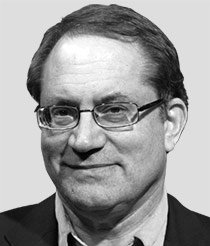"Fake news" is a particularly provocative concept applied to market forecasts now that central banks have destroyed free markets and free thought after the financial crisis. Guesses about where the market is going - and believe me, they are only guesses, some more educated than others - may appear to be grounded in facts and figures but ultimately tell us more about the psychology of the forecaster than anything meaningful about the markets.
Right now, there is overwhelming consensus among forecasters that 2017 is going to be a good year for stocks and a bad year for bonds. The fact that virtually no strategist, and certainly no strategist working for a large financial institution, is calling for stocks to decline should be taken with a grain of salt. They never call for stocks to decline (and if they do they are dismissed as "permabears" and treated with disdain). They are paid to publish bullish forecasts, which renders their advice worthless. Broken clocks can't tell time. Like large metropolitan newspapers (you know which ones I'm talking about) whose readership is plunging because news is freely available elsewhere and their tired editorial views are discredited by the experiences of their readers, Wall Street is digging its own grave through its own obvious inauthenticity.
That inauthenticity is especially toxic when it leads to passive investment strategies like this one.
This investment vehicle is the perfect product for a world of fake news, as it relies entirely on the suppression of individual thought. It is a disturbing rabbit hole of consensus thinking and if you fall down it, you may never find your way back out.
I nearly got sucked down this hole myself a couple of years ago. Here's how you can avoid it.
The ETF Phenomenon Distorts The Markets In A Dangerous Way
Inside ETFs is a massive annual ETF conference held every January in Hollywood, Florida. I attended it a couple of years ago when, in a momentary lapse of judgement that will not be repeated, I briefly considered managing a high yield bond ETF. Fortunately I came to my senses and abandoned the project. I have attended and spoken at many large investment conferences going back to the famous Drexel Burnham Junk Bond Conferences of the 1980s, but Inside ETFs ranks among the largest and most overheated conferences I ever witnessed. It reminds me - and this is not a good thing - of the securitization conferences of the 2000s held in Las Vegas (they were featured in the film The Big Short) that grew larger and larger until they (along with the mortgage industry) imploded during the financial crisis of 2008.
ETFs have come to play an outsized role in the markets; like virtually anything that Wall Street touches, they are prone to excess and unintended consequences. Passively investing in ETFs seems to be the order of the day though I strongly believe that active strategies in the right hands will always outperform passive investments over the long run. The problem, however, is that the number of truly capable active managers is extremely limited, something investors are only beginning to discover in a central bank inflated market but will be overwhelmed with when the market runs into serious trouble again. Until then, however, they will continue to close their eyes, park their brains at the door, and buy ETFs.
The structural or technical problem that ETFs introduce into markets is that they create a momentum engine whereby the value of the stocks or bonds that are included in the largest and most liquid ETFs are inflated by the liquidity that flows into these vehicles. Since Election Day, a flood of money flowed into equity ETFs. And in all of 2016, investors poured $375 billion into ETFs, more than the $348 billion they invested in 2015 according to Blackrock. This liquidity was not attracted to the individual stocks or bonds owned by the ETFs but to the overall basket of stocks and bonds held by the vehicle. This divorces the value of the individual holdings from their fundamental financial condition. As new money pushes the value of an ETF higher, it also pushes the value of individual stocks or bonds in the ETF higher without regard to their fundamentals, distorting prices and creating artificial demand that exacerbates individual stock or bond risk and systemic risk. This is exactly what happened in the securitization market with respect to debt instruments like corporate bank loans and mortgages in the years leading up to the financial crisis. I need not remind readers that the story didn't end well.
There is abundant evidence that stocks and bonds that are included in large ETFs trade at premiums to those that find themselves excluded from these popular vehicles, creating trading opportunities but also distorting capital flows and setting markets up for greater volatility and potential dislocations. If history chooses to rhyme this time, a lot of people are going to be singing the blues.
Do you think passive strategies, computer-driven trading and ETFs would flourish in a world where independent thinking was valued? Of course not. ETFs are truly the perfect investment product for a world of "fake news," which means you need to be aware of how they distort the prices of the stocks and bonds they own. They still serve an important purpose, especially those that track established indexes like SPDR S&P 500 ETF Trust (NYSEARCA: SPY) or that provide exposure to certain sectors like gold miners like the ones I recommend in my 2017 forecast. And of course, they can be used to create opportunities on the short side, some of which you can find here.
Sincerely,
Michael
The post This Investment Strategy Is Completely Driven By Fake News (And It's A Real Danger) appeared first on Sure Money Investor.
About the Author
Prominent money manager. Has built top-ranked credit and hedge funds, managed billions for institutional and high-net-worth clients. 29-year career.



